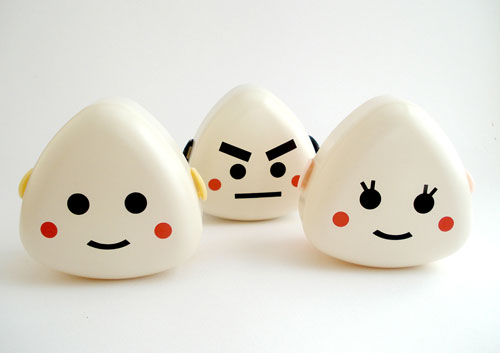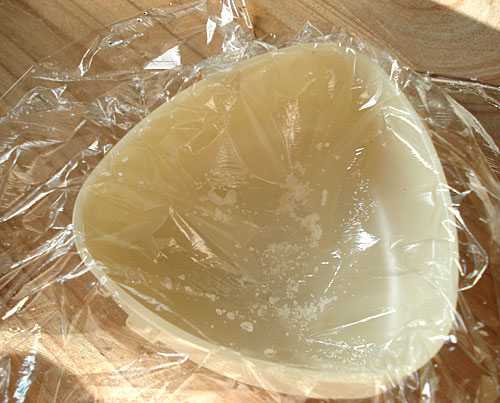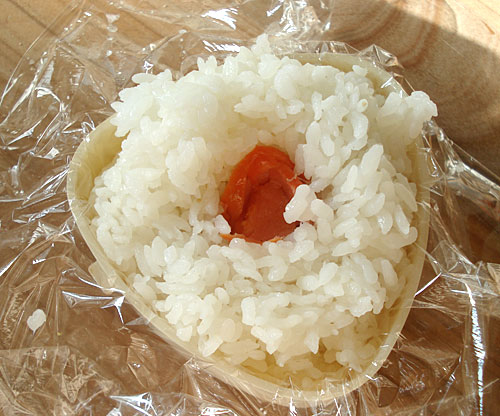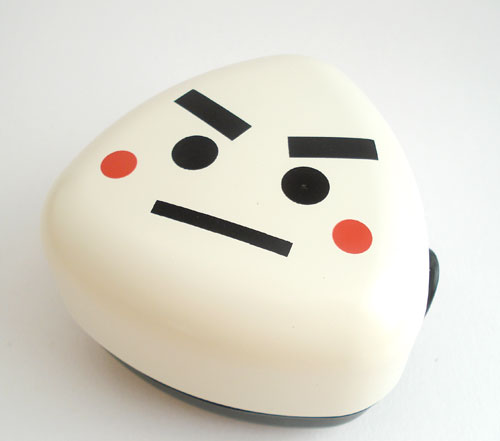How to use a single-onigiri bento box
I really, really don't need any more bento boxes. But when I spotted these incredibly adorable little onigiri boxes, I just couldn't resist.

Since I have adopted them, it's a good opportunity to show how to use this type of single-onigiri box.
These are meant to hold a single onigiri plus a little something else, so unless you have a very small appetite they are supplementary boxes to use for snack bentos. This particular model, which is made by Hakoya, has a lid section that holds a single onigiri, and a bottom section with an inner plastic lid that holds whatever sides you want with your onigiri. The box snaps shut with two little plastic clips, which are the 'ears' on the faces.
You can use the lid part as a mold and measuring cup for making your onigiri, using the plastic wrap/cling film and cup method. Here I have lined the lid/cup with plastic wrap, moistened the surface and sprinkled some salt.

I then pack in some rice. The lid/cup holds about 3/4th of a U.S. cup of rice, about 160ml and 160 calories - or 1 Japanese bowl of rice (一膳 ichizen). The filling is salted salmon, one of my favorites.

I then form and wrap the onigiri, following the steps detailed on the plastic wrap onigiri forming page, making sure that the onigiri ends up as a triangle.
The onigiri fits perfectly in the lid. The nori seaweed strips are tucked outside the plastic wrap to prevent them from getting soggy. I wrap them around the onigiri when I eat it. The little compartment holds some forgotten vegetable kinpira. You could pack some finger-foods in there if you want a utensil-free mini bento. The total calories in this particular mini-bento: about 210.

Where to get the onigiri bento boxes

I bought these amazingly cute beasties from Bento & Co., a relatively new online bento gear store. Based in Kyoto, Bento & Co. is run by a French guy, Thomas, and his Japanese wife Erico. It's the most attractively designed bento site I've ever seen, with terrific pictures and great descriptions of all of the boxes they carry, including critical information for bento box collectors like capacity in mililiters, what material the box is made of, and so on. The selection of boxes and accessories is not huge, but really tasteful. I find myself coveting about 90% of their stock!
At the moment the site is in French only, but Thomas tells us that they are working on an English version of the site. In the meantime, you can email them in English (or French of course) about anything on their site at contact@bentoandco.com. They ship worldwide from Japan. (We have no affiliation with Bento & Co. And yep, I ordered all three onigiri boxes. How could you choose between them?) Update: Bento&co. now has an English version of their site, and we're happy to have them on board as advertisers on JustBento- since I was a repeat customer well before that!
If you enjoyed this article, please consider supporting this site by becoming my patron via Patreon.
